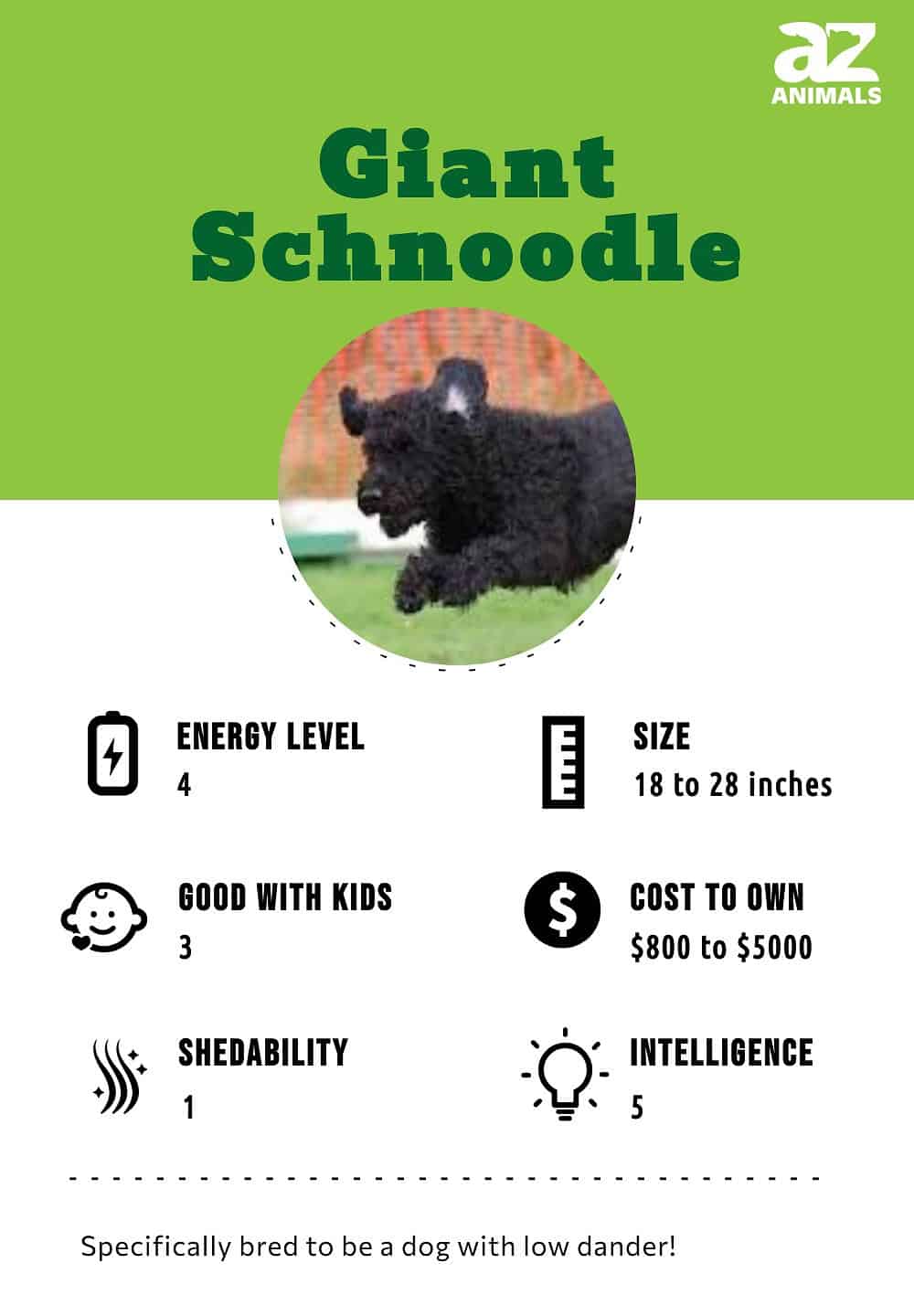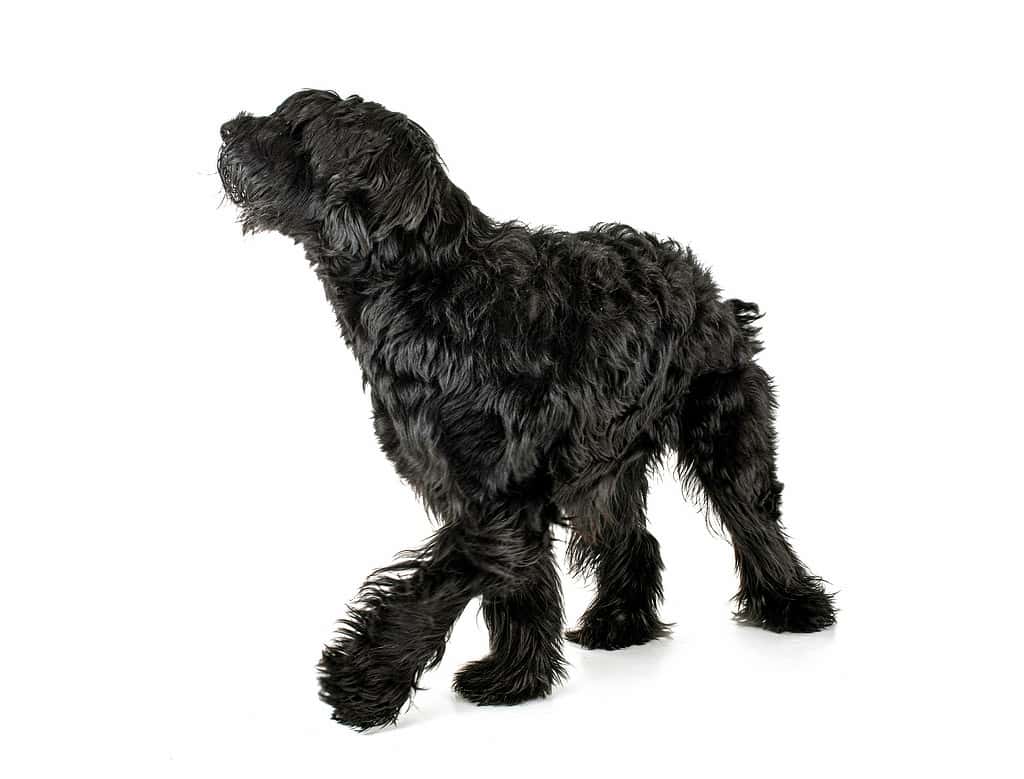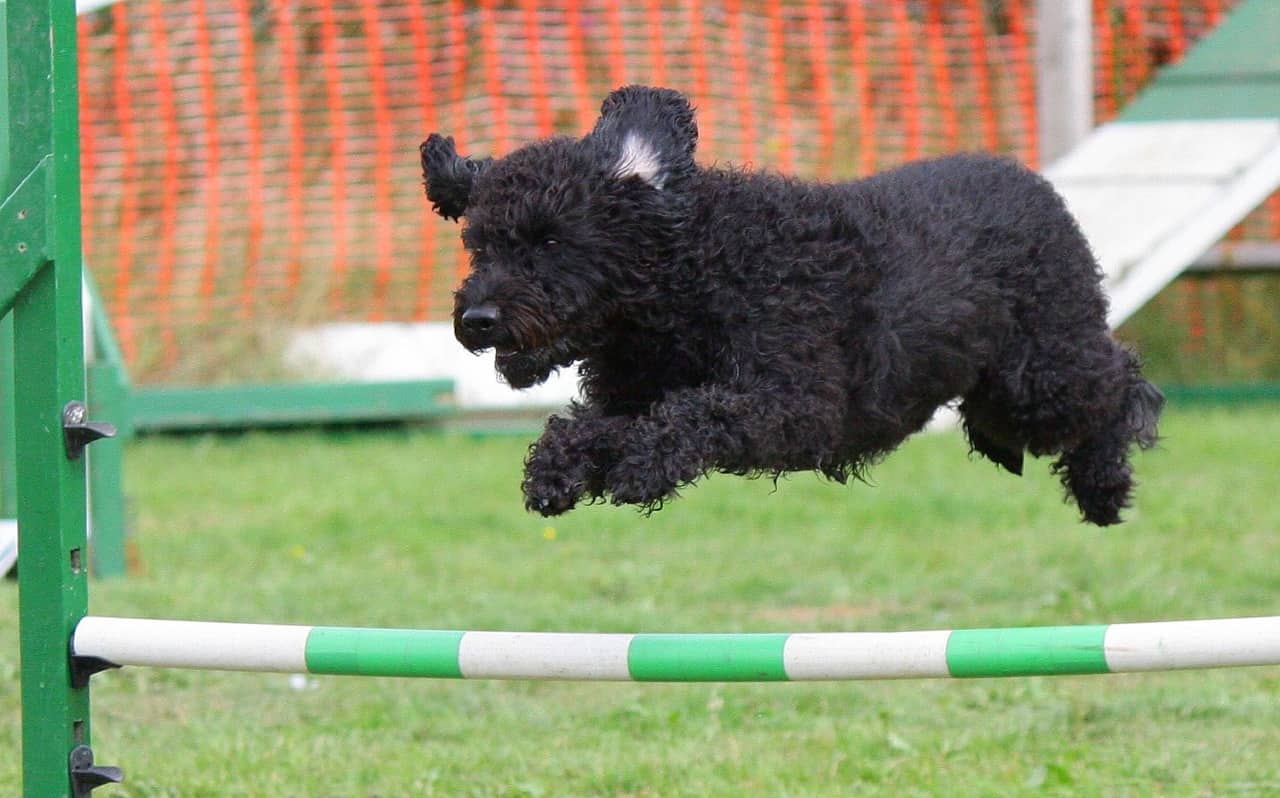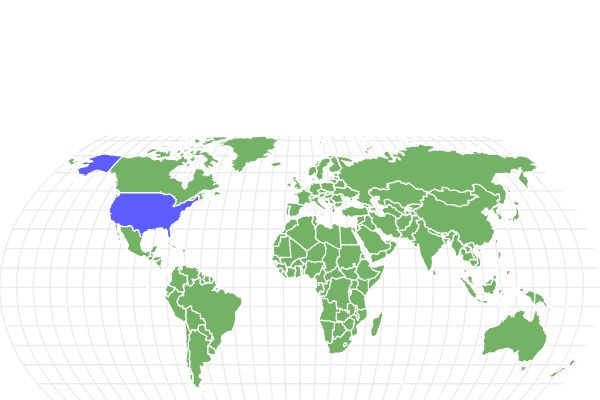Giant Schnoodle
Canis lupus
Both parents of the Giant Schnoodle are hypoallergenic, making this one of the Doodle breeds that's safest for dander-sensitive owners.
Advertisement
Giant Schnoodle Facts
Giant Schnoodle Physical Characteristics
Giant Schnoodle as a Pet:
- General Health
- Energy Level
- Shedability
- Trainability
- Intelligence
- Tendency to Chew
- Size
- Family and kid friendliness
- Yappiness / Barking
- Low
- Hypoallergenic
- Yes
- Separation Anxiety
- Moderate
- Preferred Temperature
- Average climate
- Exercise Needs
- High
- Friendly With Other Dogs
- Moderate
- Pure bred cost to own
- $800 - $5,000
- Dog group
- Terrier
- Male weight
- 60-110 lbs
- Female weight
- 55-75 lbs
This post may contain affiliate links to our partners like Chewy, Amazon, and others. Purchasing through these helps us further the A-Z Animals mission to educate about the world's species.
View all of the Giant Schnoodle images!
Both of the Giant Schnoodle’s parent breeds are working dogs that are used to a lot of exercise. Your dog might be a bit introverted, but don’t let that fool you – these dogs need plenty of time to walk, run, and play with their families.
The Giant Schnoodle is a popular designer dog that’s bred by crossing a Giant Schnauzer with a classic poodle. These dogs are tall, stately, and completely stylable with their coats of curly and hypoallergenic hair. Owners of this variety also know that their dogs are loyal, brave, sweet, and shy.
See all of our expert product reviews.
Giant Schnoodles are inquisitive dogs that make a great addition to mellow families. If you’re looking for a hypoallergenic pet that will follow you around the house, this dog is an excellent choice.

3 Pros And Cons Of Owning A Giant Schnoodle
| Pros! | Cons! |
| Calm and Quiet: They have even temperaments and don’t require a lot of attention from their owners. Expect your dog to follow you around the house; if you reach down and pet them once in a while, they’ll be incredibly satisfied. | Needs Exercise: They are large dogs with high exercise needs. If they don’t have room to run around, these dogs can pick up destructive behaviors like chewing. |
| Hypoallergenic: Like both of their parent breeds, they have low-shed, hypoallergenic coats. | Extra Grooming: Like all Doodle dogs, these dogs require regular combing and trimming to prevent their coat from getting matted. Because these dogs have sensitive skin, they’ll require special products and extra attention. |
| Easily Trained: They are a loyal, compliant, and intelligent dog that loves their owners and is incredibly easy to train. | Social Introvert: They love to socialize, but they get tired quickly. Your large dog may have a hard time making it through parties and other extended social encounters. |
History Of The Breed
The giant Schnoodle is a relatively newer breed of dog and as such, it doesn’t have much of a history. It began in the 1980s, specifically because breeders wanted a dog that wouldn’t shed much and had low dander. They took two breeds, the Poodle and the giant Schnauzer, that are known to be hypoallergenic and bred them to get the giant Schnoodle.
Its parent breeds go back further in history. The poodle, although it is the national dog of France, and is thought to have originated there, actually got its start in Germany, and was bred as a hunting dog. Their name means “to splash in the water” and comes from the German word pudel. Poodles are believed to have started in the middle ages.
The giant schnauzer is a crossbreed of the standard schnauzer, the great danes and the Bouvier des Flandres. Originally intended as a cattle dog for taking the herd to markets, this dog got its start in the mid-1800s.
Size And Weight

Giant Schnoodles are quite tall and usually stand around 28 inches at the shoulder.
Health and Entertainment for your Giant Schnoodle
- The Best Wet Food for Senior Dogs
- The Best Dog Food for Labrador Retrievers (Senior, Puppy, and Adult)
- These Are the Best Probiotics for Dogs (They Actually Work)
- Victor Senior Healthy Weight Dog Food Review: Recalls, Pros, Cons, and More
- The Best Dog Food for Small Dogs (Puppy, Adult, Senior): Ranked and Reviewed
See all of our expert product reviews.
©cynoclub/ via Getty Images
Giant Schnoodles are large dogs with soft eyes, big paws, and coats of silky and curly hair. These dogs are quite tall and usually stand around 28 inches at the shoulder. Male dogs usually weigh significantly more than their female counterparts; the maximum weight for a female is 75 pounds, but the maximum weight for a male is 110 pounds.
| Height (male): | 22 to 28 inches |
| Height (female): | 18 to 26 inches |
| Weight (male): | 60 to110 pounds |
| Weight (female): | 55 to 75 pounds |
Common Health Issues
Giant Schnoodles are designer dogs that may be prone to several health issues. Hip dysplasia in particular is highly present in both parent breeds. Most breeders will check both the parents’ and the puppies’ hips, but you should still take your new pup to the vet for an x-ray immediately after you adopt them. Other health problems to look out for include weight problems, cataracts, and heart problems.
- Hip dysplasia
- Elbow dysplasia
- Weight control issues
- Cataracts and other retinal problems
- Heart issues
- Epilepsy
Temperament
Giant Schnoodles have kind, loyal, and loving personalities. These dogs are incredibly intelligent and love to pay attention to everything that their owner is doing. They can easily attach to a single parent, so expect your dog to follow you all around the house. Other attached behaviors might include sleeping at your feet and barking when strangers come near you.
In general, Giant Schnoodles have a friendly temperament and do well with social interactions. However, these dogs are clearly introverts. To ensure that your pet stays on its best behavior, make sure to end social encounters before your dog gets too tired.
How To Take Care Of A Giant Schnoodle
Giant Schnoodles are loving, low-maintenance dogs that don’t require too much extra attention. As long as you’re willing to groom your dog regularly and let them stay in the same room as you, you should have no problem taking care of your pet.
The Best Dog Food For Giant Schnoodles
Giant Schnoodles are large, food-oriented dogs that need to eat more than the average pup. Look for high-quality kibble with a moderate cost and a good ingredients list. Alternatively, you can cook food for your pet at home; focus the diet on cooked meats, green vegetables, and various supplemental whole grains and fibers. While you regularly take your dog to the vet, talk about weight and heart health. Also, consider getting legume-free dog food to avoid heart failure linked to legumes.
So, the A-Z Animals pick for the best Giant Schnoodle dog food is Diamond Naturals Light Dry Dog Food Lamb Meal and Rice Formula with Lean Protein from Real Lamb, Probiotics, and Essential Nutrients.
Ideal for dogs like Giant Schnoodles with joint issues, this food packs a joint support punch by supplementing glucosamine and chondroitin. Plus, instead of potentially detrimental legumes like peas and lentils, nutrients like l-carnitine and taurine promote improved heart health. Taurine has the additional benefit of helping the eyes, especially combined with vitamin A. Since this food is nutrient-dense, your Giant Schnoodle is more likely to feel full rather than overeating.
You can find Diamond Naturals Light Lean Protein Dry Dog Food on Chewy or Amazon.
- Made in the USA using quality ingredients from trusted domestic and global sources.
- Real pasture-raised lamb protein as the #1 ingredient, supports the needs of less active and overweight dogs.
- Omega fatty acids for skin and coat health
- Vitamins and minerals from superfoods, including fruits like blueberries and oranges.
- Includes probiotics, antioxidants and prebiotics to support healthy digestion, immune system health and overall wellness.
- No corn, wheat, artificial flavors or colors.
Maintenance And Grooming
Giant Schnoodles need to be brushed daily, bathed weekly and trimmed once a month. These dogs have sensitive skin and should be washed with high-quality shampoos. Depending on the climate, your dog may need its fur oiled to keep moisture trapped near the skin. Trimming should be done according to temperature and style; always remember to trim back the bangs away from your dog’s eyes.
Training
Giant Schnoodles are intelligent and quick-witted dogs that are easy to train. Start working with your Schnoodle early to get the most dramatic results. As you work, remember that Schnoodles may tire easily; try keeping training sessions short to avoid triggering behavior issues.
Exercise

The Giant Schnoodle is a loyal, and intelligent dog that is incredibly easy to train but needs a consistent amount of exercise.
©Pxhere, CC0 1.0 – License
Giant Schnoodles are large dogs that need a consistent amount of exercise. If your pup doesn’t get at least an hour of good exercise every day, you can expect to see destructive behaviors and separation anxiety. These dogs do best with access to a backyard, but you can also supplement an indoor lifestyle with regular runs. As your dog gets older, expect them to slow down and require less exercise over time.
Puppies
Giant Schnoodle puppies are much more energetic than adults of the same breed. These dogs are intelligent but shy; if you lead them around the house and take an active interest in their training, you should see an amazing amount of loyalty, obedience, and receptivity.
Giant Schnoodles And Children
Giant Schnoodles are sweet and patient dogs that do well with older children. However, because these dogs are introverted, they have a hard time tolerating young children who can’t respect canine boundaries. They aren’t recommended for large families, and all social interactions with children should be supervised.
Dogs Similar To Giant Schnoodles
Giant Schnoodles are large dogs with calm and intelligent personalities. When you’re looking for a similar dog, think about whether it’s the size, temperament, or physical traits that really set this dog apart for you. Some of the most similar breeds on the market include the Giant Schnauzer, the standard Schnoodle, and the Black Russian Terrier.
- Giant Schnauzer – One of the Giant Schnoodle’s parent breeds, Giant Schnauzers are bold, loyal, and classic dogs. They’re also hypoallergenic and easy to train, making them great pets for most situations.
- Schnoodle – If you love the characteristics of this variety but need a smaller dog, a regular Schnoodle might be exactly what you’re looking for. In exchange for their decreased size, these dogs are more playful, gregarious, and excited.
- Black Russian Terriers – Another descendant of the Giant Schnauzer, the Black Russian terrier is a carefully curated breed with a great personality. These pups are calm, sweet, and hardworking, making them a beloved choice as rescue animals.
Giant Schnoodle Vs. Giant Schnauzer
The Giant Schnauzer is known for being an independent, playful, and gregarious breed. In contrast, the Giant Schnoodle is slightly more reserved and attached to its owner. Both breeds are strikingly physically similar, although the Giant Schnoodle has curlier hair and typically stands an inch or two taller. One of the biggest differences can be found in the face; if you place these two dogs side-by-side, the Schnoodle’s poodle ancestry becomes readily apparent.
Popular Names For Giant Schnoodles
Popular names for Giant Schnoodles include:
- Maxie
- Bismark
- Misty
- Lola
- Harley
- Oscar
- Roman
- Rosie
- Velvet
- Dinah
- Penny
- Sergeant
Giant Schnoodle FAQs (Frequently Asked Questions)
What is a Giant Schnoodle?
The Giant Schnoodle is a designer dog breed that was created by mixing a poodle with a Giant Schnauzer. These two breeds were combined because they share similar hypoallergenic hair and other physical traits. The result is a large dog with thick curls, big paws, and an incredibly loyal personality.
How much do Giant Schnoodles cost to own?
The price of a purebred Giant Schnoodle can range anywhere from $800 to $5,000. Different breeders will have their own standards, especially because the Giant Schnoodle is a designer breed instead of a registered breed. If you pay a higher price, expect to see a more thorough pedigree and better training practices. You may also be able to rescue a Giant Schnoodle from your local shelter, although you won’t be able to verify the dog’s genetics.
Are Giant Schnoodles good with kids?
Giant Schnoodles are friendly dogs and do fairly well with children. However, because both of their parent breeds are introverted in nature, Giant Schnoodles tend to get tired easily; for everyone’s safety, do your best not to leave them alone with children for extended periods of time.
How long does a Giant Schnoodle live?
Giant Schnoodles can live anywhere from 10 to 15 years, especially if they are fed a healthy diet and taken outside for regular exercise.
How big do Giant Schnoodles get?
Giant Schnoodles are large dogs that stand tall compared to other canines of their size. They can stand as tall as 28 inches, and they typically weigh anywhere from 50 to 110 pounds. In general, Giant Schnoodles are actually a little bit bigger than their Giant Schnauzer counterparts.
Are Giant Schnoodles hypoallergenic?
Both the Giant Schnauzer and the poodle are considered to be hypoallergenic dogs. Because of this, it’s assumed by breeders that any Giant Schnoodle will be hypoallergenic as well. This trait explains the high price of Schnoodles and other types of Doodle dog, as well as how quickly they get adopted from rescues.
Are Giant Schnoodles aggressive?
Giant Schnoodles may be large, but they are not particularly aggressive. These dogs are most likely to bark and then back away if they end up in an unfriendly encounter.
Are Giant Schnoodles good family dogs?
Giant Schnoodles are sweet, loving, and slightly introverted dogs. This makes them a good choice for quiet families, but they may have a hard time fitting into high-energy households. These dogs do best around older children or adults.
How do you groom a Giant Schnoodle?
Giant Schnoodles need to be carefully washed and combed on at least a weekly basis. Because their skin is so sensitive, you will need to choose products that are good for delicate skin and soft fur. Then, lightly trim your Giant Schnoodle’s coat down to the desired length. Don’t forget to style your Giant Schnoodle’s face, and remember that you always need to trim their bangs so they can see.
Thank you for reading! Have some feedback for us? Contact the AZ Animals editorial team.
Sources
- petguide.com, Available here: https://www.petguide.com/breeds/dog/giant-schnoodle/
- dogbreedplus.com, Available here: https://www.dogbreedplus.com/dog_breeds/giant_schnoodle.php
- dogtime.com, Available here: https://dogtime.com/dog-breeds/schnoodle#/slide/1
- dogbreedinfo.com, Available here: https://www.dogbreedinfo.com/g/giantschnoodle.htm
- doggiedesigner.com, Available here: https://doggiedesigner.com/giant-schnoodle/
- cuteness.com, Available here: https://www.cuteness.com/article/groom-schnoodle-dog


















